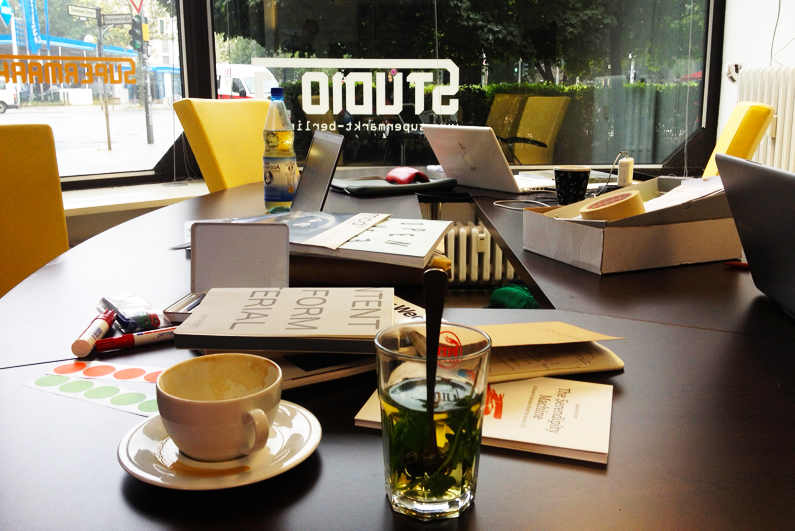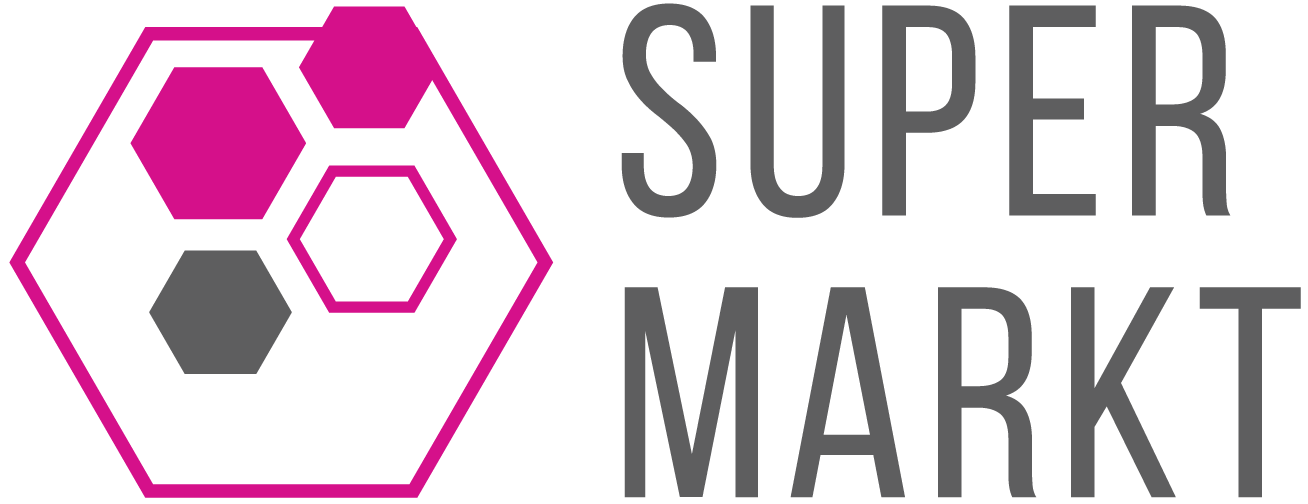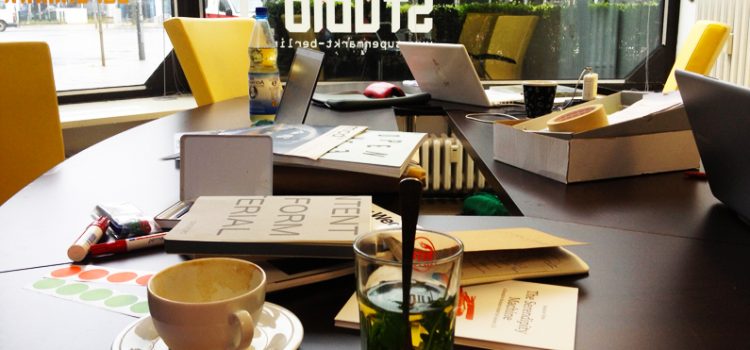
From the last week of September SUPERMARKT is home to a study table with a regularily changing collection of books, magazines, articles and pictures. The first month this table will be filled with materials about coworkingspaces. Parellell to the table there is a Tumblr page with pictures, texts, videos, podcasts, etcetera. It is our idea that the content of both the study table and the Tumblr should grow gradually, with contributions from our visitors.
Take a look at http://coworkingsupermarkt.tumblr.com/ and comment or add!
The study table will be opened with a small workshop on Tuesday September 24 at 15.00. You are very welcome to come over and join. The blog is already running.
The idea – a study table where visitors can contribute
The first reason to start a study table is that SUPERMARKT is very appropriate as a study room. There is a lot of space, pleasant daylight, big windows with an interesting panorama, a gentle hum and a smell of coffee from the café. We would love to to cut into this possibility that the space offers. And we are curious what added value it could be for the visitors of SUPERMARKT.
The table and the accompanying blog are collaborative, because the community can be an infinite source of associations and knowledge. We would like to see what an amazing collection our community can gather collectively – on both the physical and the digital table.
A quick excursion to the artworld. Such tables are an interesting curatorial experiment. They show the research process of the curator – in this case an open group of curators – instead of a finished exhibition. You will find the reading table as if a curator walked away to eat a sandwich just a moment ago, in the middle of his research. It fits to a present ‘trend’ in the artworld of exhibiting the curatorial process itself. An artwork that is interesting in this light is The Marx Lounge by Chilean artist Alfredo Jaar. The Marx Lounge, shown at the Liverpool Biannual in 2010 and at the Stedelijk Museum Bureau Amsterdam in 2011, is a giant table full of neo-marxist literature. Visitors could nestle in a cozy sofa to study and possibly debate. Also interesting are tributes to famous, or even canonized, exhibitions and artistic events from the past. The Stedelijk Museum in Amsterdam recently devoted two exhibitions to restaging and recontextualizing three famous exhibitions from the 1960s: Dylaby (1961), Bewogen beweging (1962) and Op losse schroeven (1969). The ‘recollections’ of these exhibitions did not only show the artworks, but also archival materials like notes from the curators and letters between the curators and artists.
Back to the study table at SUPERMARKT. Within the team we were discussing whether our study table could be called a ‘physical Tumblr page’. This is an interesting discussion, maybe we could talk about it at the opening on September the 24th. For now we came as far as: In a way this would make sense: the reading table is a place where information is gathered associatively. The collection is growing over time, and supplemented by different people. On the other hand there is a contradiction (of generations, of media epochs?): learning from books goes slow, and requires concentration and a certain determination. Blogs, on the other hand, are very quick and associative. The content has to strike immediately, or it will be clicked away (some people call this superfiscial). But then again: picture books can work a bit like that as well. You flip through the pages looking for something that is interesting enough to devote your attention to.
Why a study table about coworking spaces?
The study table is a side event to ‘Work Around’, a three days programme about new workforms and self organization that we are organizing in the end of October. One of the topics of this event is the development towards more flexible contracts, work settings and spaces. In this reality there is a lot to gain in learning about inspiring and efficient working space. Simultaneously the study table is a next step in our investigation about Serendipity (link somehow). Quickly summarized we are interested in the question how space, light, sound and social setting can influence creativity and productivity. By gathering a lot of pictures and thoughts about coworking and space, we stimulate ourselves to think about the future of SUPERMARKT. I found out that there are quite some nice books about coworking spaces. But almost none are available in the libraries of Berlin. As the first venue to ‘open’ these books to the public, we might draw a big audience in this city of freelancers!
What can you do practically:
-Come over to SUPERMARKT (from 24-09 on), flip pages, read, study.
-Add something to the table: books, magazines, articles, pictures…
-Have a look at the Tumblr, comment or bring in subjects by writing to coworkingsupermarkt@gmail.com. You can also throw an idea in the box of suggestions.
Ela Kagel, Katharina Meyer, Katerina Michailidi, Kate Martin, Tessa Verheul Thanks a million for thinking along!From the last week of September SUPERMARKT is home to a study table with a regularily changing collection of books, magazines, articles and pictures. The first month this table will be filled with materials about coworkingspaces. Parellell to the table there is a Tumblr page with pictures, texts, videos, podcasts, etcetera. It is our idea that the content of both the study table and the Tumblr should grow gradually, with contributions from our visitors.
Take a look at http://coworkingsupermarkt.tumblr.com/ and comment or add!
The study table will be opened with a small workshop on Tuesday September 24 at 15.00. You are very welcome to come over and join. The blog is already running.
The idea – a study table where visitors can contribute
The first reason to start a study table is that SUPERMARKT is very appropriate as a study room. There is a lot of space, pleasant daylight, big windows with an interesting panorama, a gentle hum and a smell of coffee from the café. We would love to to cut into this possibility that the space offers. And we are curious what added value it could be for the visitors of SUPERMARKT.
The table and the accompanying blog are collaborative, because the community can be an infinite source of associations and knowledge. We would like to see what an amazing collection our community can gather collectively – on both the physical and the digital table.
A quick excursion to the artworld. Such tables are an interesting curatorial experiment. They show the research process of the curator – in this case an open group of curators – instead of a finished exhibition. You will find the reading table as if a curator walked away to eat a sandwich just a moment ago, in the middle of his research. It fits to a present ‘trend’ in the artworld of exhibiting the curatorial process itself. An artwork that is interesting in this light is The Marx Lounge by Chilean artist Alfredo Jaar. The Marx Lounge, shown at the Liverpool Biannual in 2010 and at the Stedelijk Museum Bureau Amsterdam in 2011, is a giant table full of neo-marxist literature. Visitors could nestle in a cozy sofa to study and possibly debate. Also interesting are tributes to famous, or even canonized, exhibitions and artistic events from the past. The Stedelijk Museum in Amsterdam recently devoted two exhibitions to restaging and recontextualizing three famous exhibitions from the 1960s: Dylaby (1961), Bewogen beweging (1962) and Op losse schroeven (1969). The ‘recollections’ of these exhibitions did not only show the artworks, but also archival materials like notes from the curators and letters between the curators and artists.
Back to the study table at SUPERMARKT. Within the team we were discussing whether our study table could be called a ‘physical Tumblr page’. This is an interesting discussion, maybe we could talk about it at the opening on September the 24th. For now we came as far as: In a way this would make sense: the reading table is a place where information is gathered associatively. The collection is growing over time, and supplemented by different people. On the other hand there is a contradiction (of generations, of media epochs?): learning from books goes slow, and requires concentration and a certain determination. Blogs, on the other hand, are very quick and associative. The content has to strike immediately, or it will be clicked away (some people call this superfiscial). But then again: picture books can work a bit like that as well. You flip through the pages looking for something that is interesting enough to devote your attention to.
Why a study table about coworking spaces?
The study table is a side event to ‘Work Around’, a three days programme about new workforms and self organization that we are organizing in the end of October. One of the topics of this event is the development towards more flexible contracts, work settings and spaces. In this reality there is a lot to gain in learning about inspiring and efficient working space. Simultaneously the study table is a next step in our investigation about Serendipity (link somehow). Quickly summarized we are interested in the question how space, light, sound and social setting can influence creativity and productivity. By gathering a lot of pictures and thoughts about coworking and space, we stimulate ourselves to think about the future of SUPERMARKT. I found out that there are quite some nice books about coworking spaces. But almost none are available in the libraries of Berlin. As the first venue to ‘open’ these books to the public, we might draw a big audience in this city of freelancers!
What can you do practically:
-Come over to SUPERMARKT (from 24-09 on), flip pages, read, study.
-Add something to the table: books, magazines, articles, pictures…
-Have a look at the Tumblr, comment or bring in subjects by writing to coworkingsupermarkt@gmail.com. You can also throw an idea in the box of suggestions.
Ela Kagel, Katharina Meyer, Katerina Michailidi, Kate Martin, Tessa Verheul Thanks a million for thinking along!

